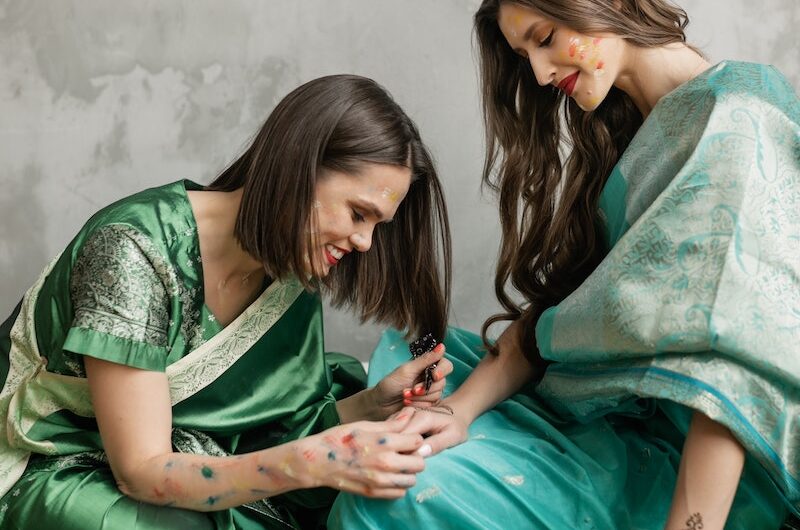For centuries, the timeless charm of a Banarasi saree has woven its way through the tapestry of Indian culture, captivating hearts and transcending generations. These exquisite garments have an allure that never fades, making them a cherished heirloom passed down from one generation to the next. Explore the enduring appeal of these sarees and why they continue to hold a special place in the hearts of Indian families.
A Legacy of Craftsmanship
They are more than just pieces of clothing; they are a testament to the rich tradition of craftsmanship that has thrived in the city of Varanasi for centuries. Skilled weavers, often working on handlooms, painstakingly create these sarees, paying meticulous attention to every detail. The intricate designs, delicate embroidery, and the use of pure silk or finely woven cotton are a testament to the dedication and skill of the artisans. This legacy of craftsmanship is one of the primary reasons they are treasured and passed down through generations.
A Symbol of Elegance
The elegance of the cloth is unmatched. These sarees effortlessly transform any woman into a picture of grace and sophistication. The lustrous silk drapes beautifully, exuding an air of regality. Whether it’s a traditional occasion like a wedding, a cultural festival, or a contemporary event, these sarees always succeed in making a statement. This versatility ensures that they remain a beloved choice for women of all ages. Moreover, the availability of the Banarasi saree online has made it even more accessible for women worldwide, allowing them to embrace this piece of timeless elegance with ease.
Cultural Significance
These sarees are deeply intertwined with the cultural fabric of India. They are not just garments; they are symbols of tradition and heritage. Often handed down as heirlooms, these sarees carry with them the stories of generations. They are worn during important rites of passage, such as weddings and festivals, signifying the continuation of tradition and the passing of cultural values from one generation to another. This cultural significance is a powerful reason why sarees are cherished and preserved within families.

Timeless Designs
One of the key factors contributing to the enduring appeal of these clothes is their timeless designs. The motifs and patterns used in these sarees draw inspiration from nature, mythology, and historical art forms. From delicate floral patterns to intricate brocade work and rich zari borders, these sarees are a testament to the enduring beauty of classic design. Their ability to transcend fashion trends ensures they remain relevant and coveted across generations.
Emotional Attachments
They are not just pieces of clothing; they are repositories of memories and emotions. Many women fondly remember watching their mothers and grandmothers drape these sarees with grace and elegance. These sarees are often associated with special moments and milestones in one’s life. The emotional attachment to these, which beloved family members have worn in the past, makes them all the more precious and encourages their preservation for future generations.
Conclusion
In a world where fashion trends come and go, a Banarasi saree is a testament to the enduring allure of timeless craftsmanship, elegance, and cultural significance. Passed down through generations, these sarees are not just pieces of fabric; they are a bridge that connects the past to the present and ensures that the legacy of tradition and beauty continues. The artistry, elegance, and emotional attachments associated with these sarees make them an invaluable treasure that will continue to grace the wardrobes of Indian families for generations to come. So, the next time you see a woman draped in this saree, remember that she carries with her not just a piece of clothing but a piece of history and tradition that transcends time.
Image Source: Pexels
Latest Posts:
- Top Things to Gift to a Friend Who Commutes
- Quick Relaxation Techniques for Blood Pressure Management
- Bold and Beautiful: Embrace the Oversize Shirt Trend
- Unleash Your Inner Y2K Diva With Cherrykitten’s Exclusive Collection
- Elevate Your Classroom Style With Teacher Tops, Shirts, Sweatshirts and Bags From Teachersgram
- Upgrade Your Workout Wardrobe: Discover Stylish Gym Sweatshirts, Hooded Tank Tops and More at Ironpandafit
- HIIT Workouts: The Ultimate Guide to High Intensity Interval Training
- Euphoria Inspired Makeup: The Bold and Artistic Trends Taking Over
- What are the 6 Most Common Online Pathology Tests?





